401081 Organisational Governance: Aged Care Reforms in Australia, 2018
VerifiedAdded on 2023/06/11
|12
|3181
|481
Essay
AI Summary
This essay delves into the demographic shifts in Australia, particularly the increasing aged population and its impact on the healthcare system. It evaluates the role of aged care reforms in supporting the elderly, addressing challenges in community aged care services, and improving information accessibility. The importance of restorative care programs is highlighted, along with the prospective potential of aged care reform packages. The essay concludes by emphasizing the need for ongoing reform to create a responsive and sustainable aged care system, offering better services and accessibility for the aging population in Australia. Desklib provides this essay along with a wide array of study tools for students.
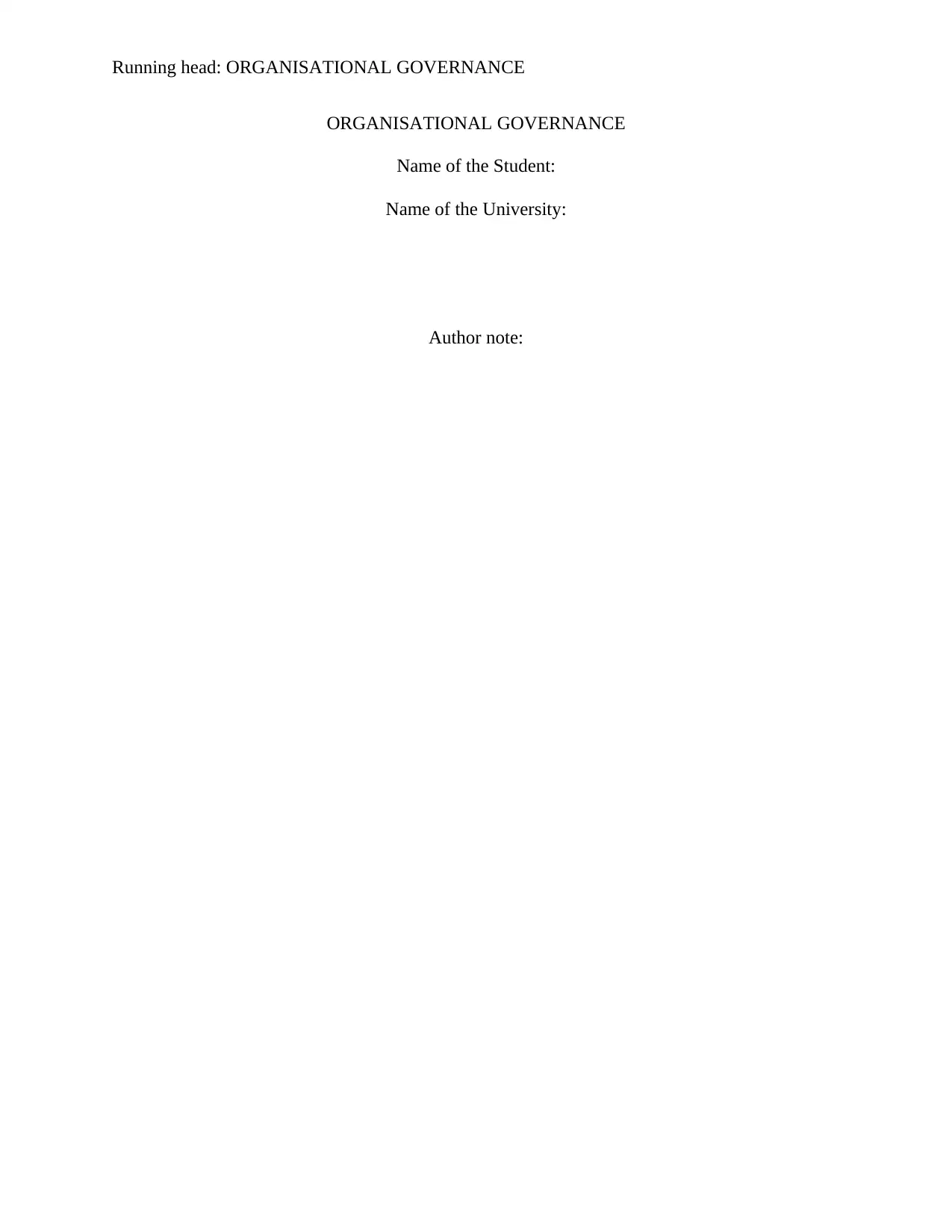
Running head: ORGANISATIONAL GOVERNANCE
ORGANISATIONAL GOVERNANCE
Name of the Student:
Name of the University:
Author note:
ORGANISATIONAL GOVERNANCE
Name of the Student:
Name of the University:
Author note:
Paraphrase This Document
Need a fresh take? Get an instant paraphrase of this document with our AI Paraphraser
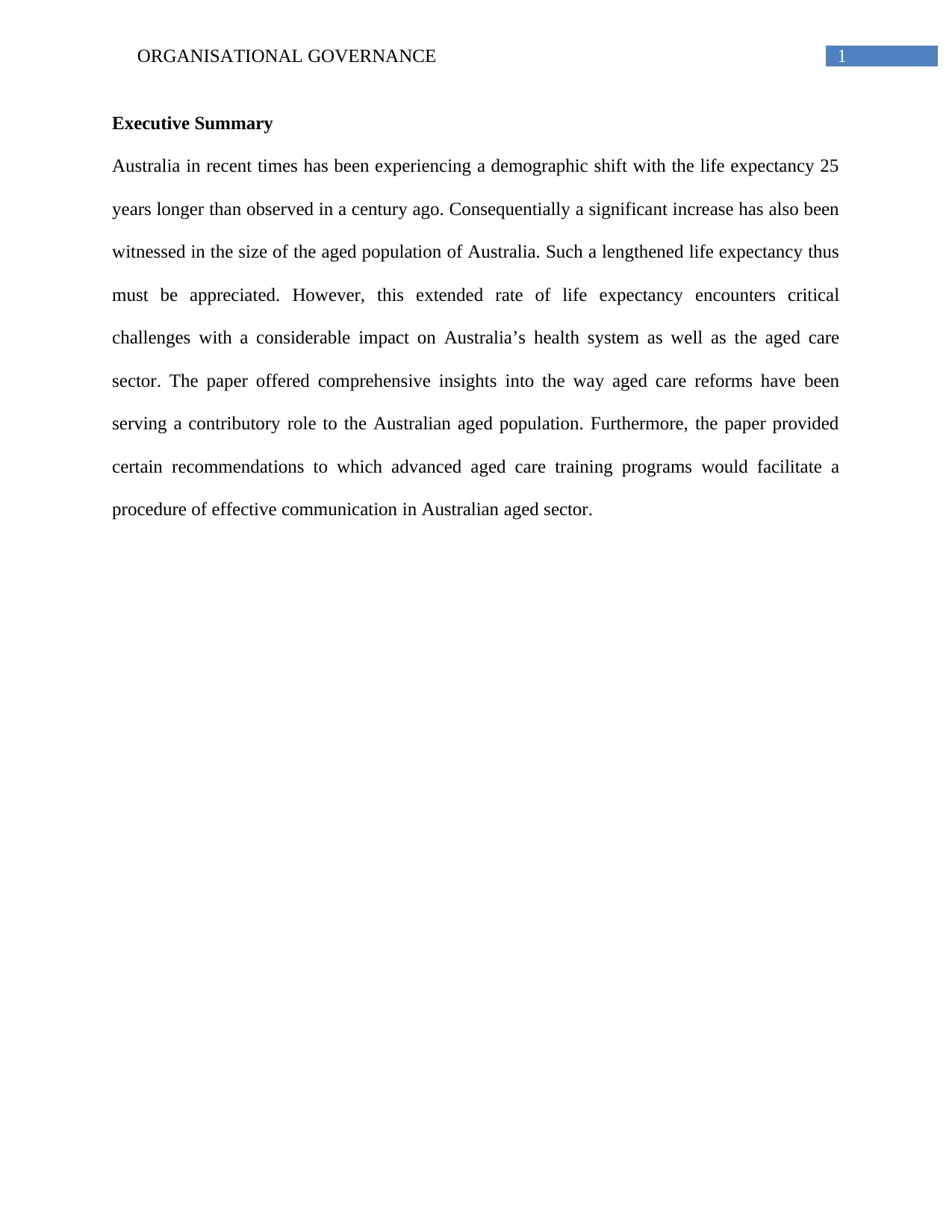
1ORGANISATIONAL GOVERNANCE
Executive Summary
Australia in recent times has been experiencing a demographic shift with the life expectancy 25
years longer than observed in a century ago. Consequentially a significant increase has also been
witnessed in the size of the aged population of Australia. Such a lengthened life expectancy thus
must be appreciated. However, this extended rate of life expectancy encounters critical
challenges with a considerable impact on Australia’s health system as well as the aged care
sector. The paper offered comprehensive insights into the way aged care reforms have been
serving a contributory role to the Australian aged population. Furthermore, the paper provided
certain recommendations to which advanced aged care training programs would facilitate a
procedure of effective communication in Australian aged sector.
Executive Summary
Australia in recent times has been experiencing a demographic shift with the life expectancy 25
years longer than observed in a century ago. Consequentially a significant increase has also been
witnessed in the size of the aged population of Australia. Such a lengthened life expectancy thus
must be appreciated. However, this extended rate of life expectancy encounters critical
challenges with a considerable impact on Australia’s health system as well as the aged care
sector. The paper offered comprehensive insights into the way aged care reforms have been
serving a contributory role to the Australian aged population. Furthermore, the paper provided
certain recommendations to which advanced aged care training programs would facilitate a
procedure of effective communication in Australian aged sector.
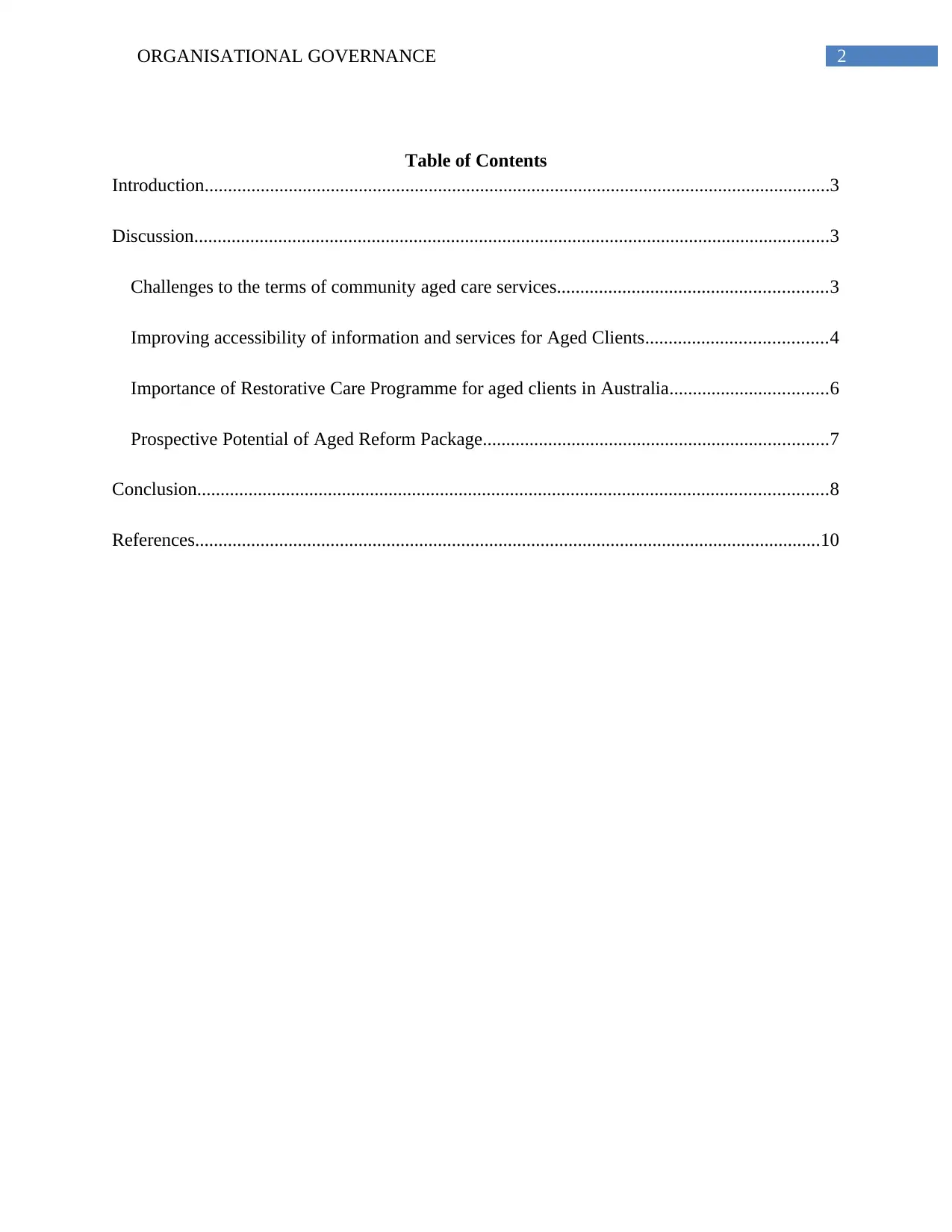
2ORGANISATIONAL GOVERNANCE
Table of Contents
Introduction......................................................................................................................................3
Discussion........................................................................................................................................3
Challenges to the terms of community aged care services..........................................................3
Improving accessibility of information and services for Aged Clients.......................................4
Importance of Restorative Care Programme for aged clients in Australia..................................6
Prospective Potential of Aged Reform Package..........................................................................7
Conclusion.......................................................................................................................................8
References......................................................................................................................................10
Table of Contents
Introduction......................................................................................................................................3
Discussion........................................................................................................................................3
Challenges to the terms of community aged care services..........................................................3
Improving accessibility of information and services for Aged Clients.......................................4
Importance of Restorative Care Programme for aged clients in Australia..................................6
Prospective Potential of Aged Reform Package..........................................................................7
Conclusion.......................................................................................................................................8
References......................................................................................................................................10
⊘ This is a preview!⊘
Do you want full access?
Subscribe today to unlock all pages.

Trusted by 1+ million students worldwide
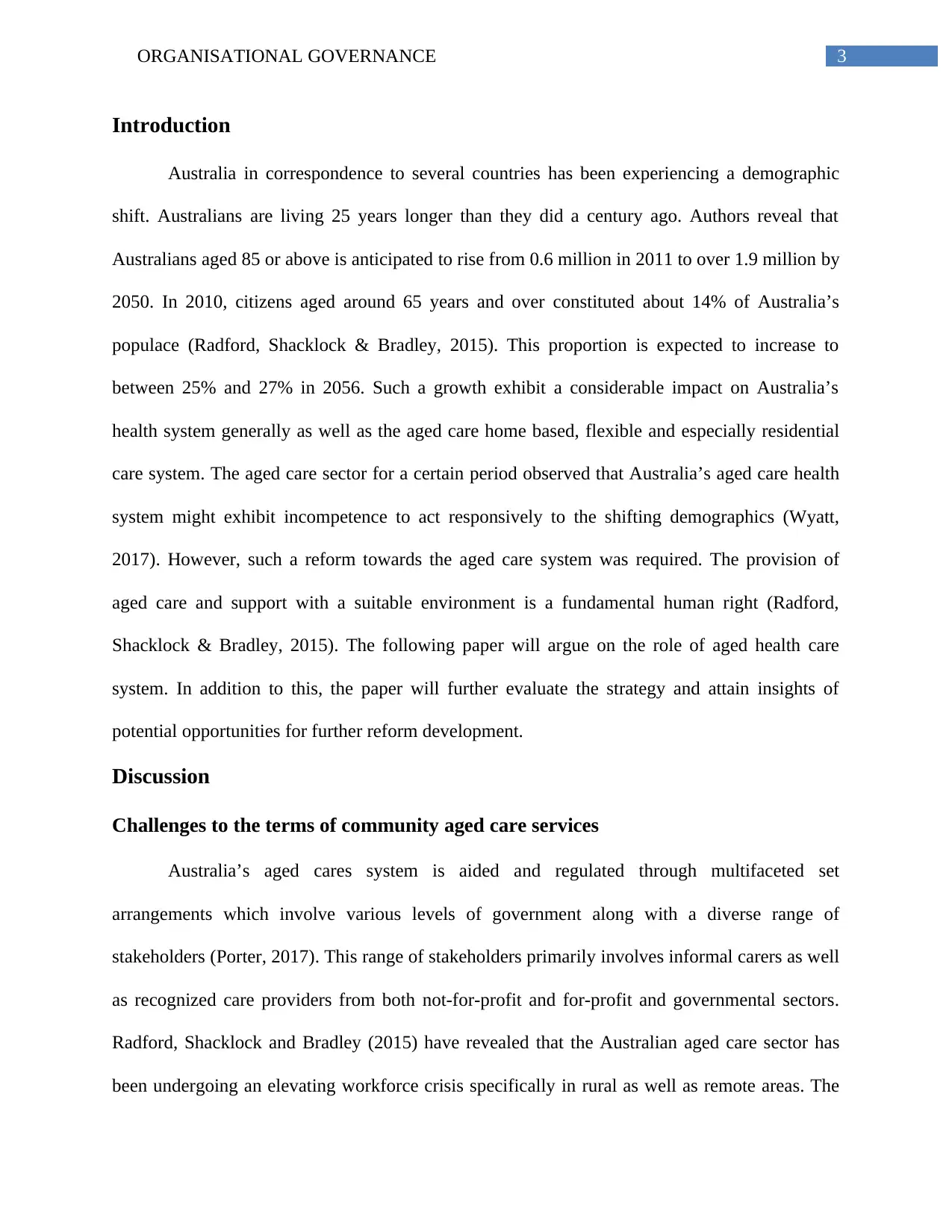
3ORGANISATIONAL GOVERNANCE
Introduction
Australia in correspondence to several countries has been experiencing a demographic
shift. Australians are living 25 years longer than they did a century ago. Authors reveal that
Australians aged 85 or above is anticipated to rise from 0.6 million in 2011 to over 1.9 million by
2050. In 2010, citizens aged around 65 years and over constituted about 14% of Australia’s
populace (Radford, Shacklock & Bradley, 2015). This proportion is expected to increase to
between 25% and 27% in 2056. Such a growth exhibit a considerable impact on Australia’s
health system generally as well as the aged care home based, flexible and especially residential
care system. The aged care sector for a certain period observed that Australia’s aged care health
system might exhibit incompetence to act responsively to the shifting demographics (Wyatt,
2017). However, such a reform towards the aged care system was required. The provision of
aged care and support with a suitable environment is a fundamental human right (Radford,
Shacklock & Bradley, 2015). The following paper will argue on the role of aged health care
system. In addition to this, the paper will further evaluate the strategy and attain insights of
potential opportunities for further reform development.
Discussion
Challenges to the terms of community aged care services
Australia’s aged cares system is aided and regulated through multifaceted set
arrangements which involve various levels of government along with a diverse range of
stakeholders (Porter, 2017). This range of stakeholders primarily involves informal carers as well
as recognized care providers from both not-for-profit and for-profit and governmental sectors.
Radford, Shacklock and Bradley (2015) have revealed that the Australian aged care sector has
been undergoing an elevating workforce crisis specifically in rural as well as remote areas. The
Introduction
Australia in correspondence to several countries has been experiencing a demographic
shift. Australians are living 25 years longer than they did a century ago. Authors reveal that
Australians aged 85 or above is anticipated to rise from 0.6 million in 2011 to over 1.9 million by
2050. In 2010, citizens aged around 65 years and over constituted about 14% of Australia’s
populace (Radford, Shacklock & Bradley, 2015). This proportion is expected to increase to
between 25% and 27% in 2056. Such a growth exhibit a considerable impact on Australia’s
health system generally as well as the aged care home based, flexible and especially residential
care system. The aged care sector for a certain period observed that Australia’s aged care health
system might exhibit incompetence to act responsively to the shifting demographics (Wyatt,
2017). However, such a reform towards the aged care system was required. The provision of
aged care and support with a suitable environment is a fundamental human right (Radford,
Shacklock & Bradley, 2015). The following paper will argue on the role of aged health care
system. In addition to this, the paper will further evaluate the strategy and attain insights of
potential opportunities for further reform development.
Discussion
Challenges to the terms of community aged care services
Australia’s aged cares system is aided and regulated through multifaceted set
arrangements which involve various levels of government along with a diverse range of
stakeholders (Porter, 2017). This range of stakeholders primarily involves informal carers as well
as recognized care providers from both not-for-profit and for-profit and governmental sectors.
Radford, Shacklock and Bradley (2015) have revealed that the Australian aged care sector has
been undergoing an elevating workforce crisis specifically in rural as well as remote areas. The
Paraphrase This Document
Need a fresh take? Get an instant paraphrase of this document with our AI Paraphraser
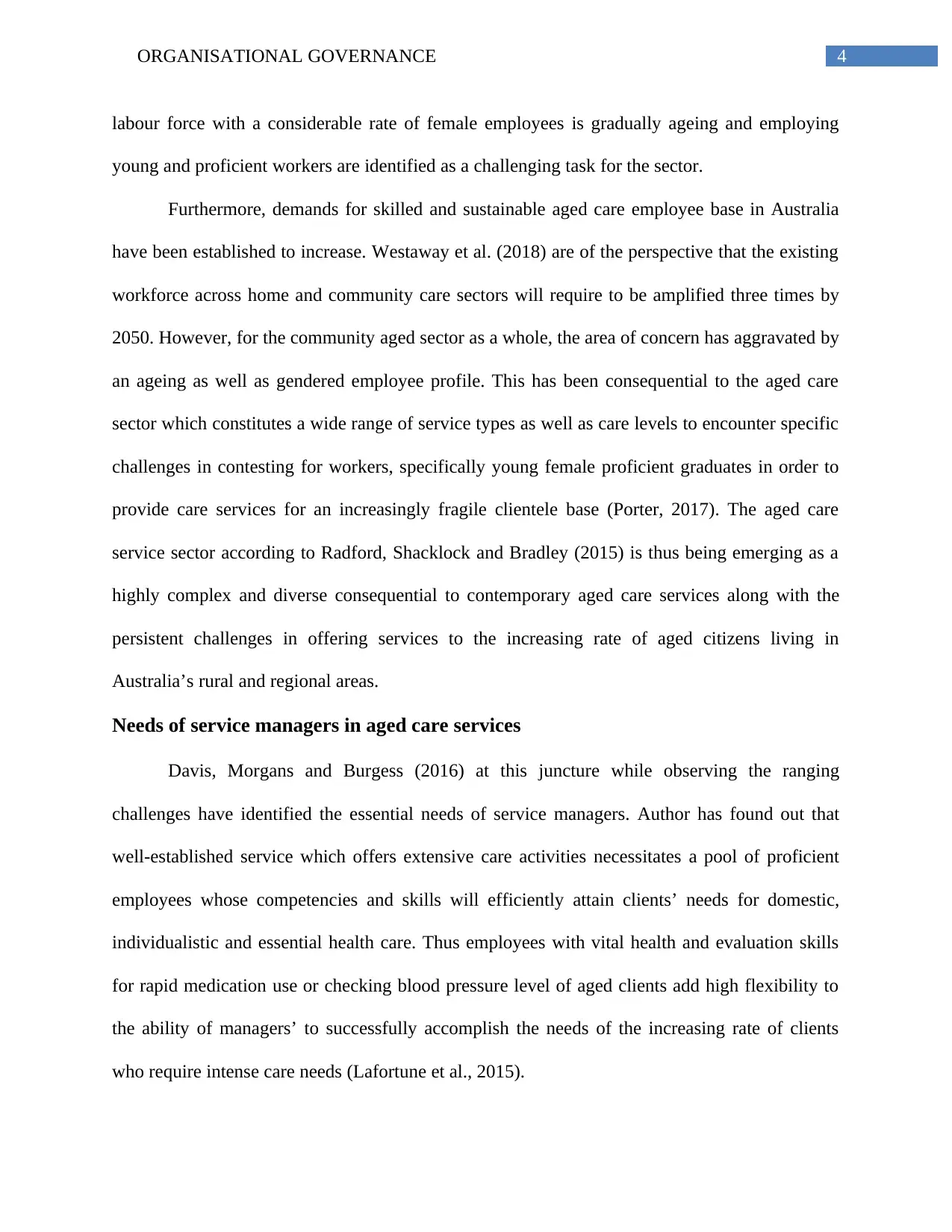
4ORGANISATIONAL GOVERNANCE
labour force with a considerable rate of female employees is gradually ageing and employing
young and proficient workers are identified as a challenging task for the sector.
Furthermore, demands for skilled and sustainable aged care employee base in Australia
have been established to increase. Westaway et al. (2018) are of the perspective that the existing
workforce across home and community care sectors will require to be amplified three times by
2050. However, for the community aged sector as a whole, the area of concern has aggravated by
an ageing as well as gendered employee profile. This has been consequential to the aged care
sector which constitutes a wide range of service types as well as care levels to encounter specific
challenges in contesting for workers, specifically young female proficient graduates in order to
provide care services for an increasingly fragile clientele base (Porter, 2017). The aged care
service sector according to Radford, Shacklock and Bradley (2015) is thus being emerging as a
highly complex and diverse consequential to contemporary aged care services along with the
persistent challenges in offering services to the increasing rate of aged citizens living in
Australia’s rural and regional areas.
Needs of service managers in aged care services
Davis, Morgans and Burgess (2016) at this juncture while observing the ranging
challenges have identified the essential needs of service managers. Author has found out that
well-established service which offers extensive care activities necessitates a pool of proficient
employees whose competencies and skills will efficiently attain clients’ needs for domestic,
individualistic and essential health care. Thus employees with vital health and evaluation skills
for rapid medication use or checking blood pressure level of aged clients add high flexibility to
the ability of managers’ to successfully accomplish the needs of the increasing rate of clients
who require intense care needs (Lafortune et al., 2015).
labour force with a considerable rate of female employees is gradually ageing and employing
young and proficient workers are identified as a challenging task for the sector.
Furthermore, demands for skilled and sustainable aged care employee base in Australia
have been established to increase. Westaway et al. (2018) are of the perspective that the existing
workforce across home and community care sectors will require to be amplified three times by
2050. However, for the community aged sector as a whole, the area of concern has aggravated by
an ageing as well as gendered employee profile. This has been consequential to the aged care
sector which constitutes a wide range of service types as well as care levels to encounter specific
challenges in contesting for workers, specifically young female proficient graduates in order to
provide care services for an increasingly fragile clientele base (Porter, 2017). The aged care
service sector according to Radford, Shacklock and Bradley (2015) is thus being emerging as a
highly complex and diverse consequential to contemporary aged care services along with the
persistent challenges in offering services to the increasing rate of aged citizens living in
Australia’s rural and regional areas.
Needs of service managers in aged care services
Davis, Morgans and Burgess (2016) at this juncture while observing the ranging
challenges have identified the essential needs of service managers. Author has found out that
well-established service which offers extensive care activities necessitates a pool of proficient
employees whose competencies and skills will efficiently attain clients’ needs for domestic,
individualistic and essential health care. Thus employees with vital health and evaluation skills
for rapid medication use or checking blood pressure level of aged clients add high flexibility to
the ability of managers’ to successfully accomplish the needs of the increasing rate of clients
who require intense care needs (Lafortune et al., 2015).
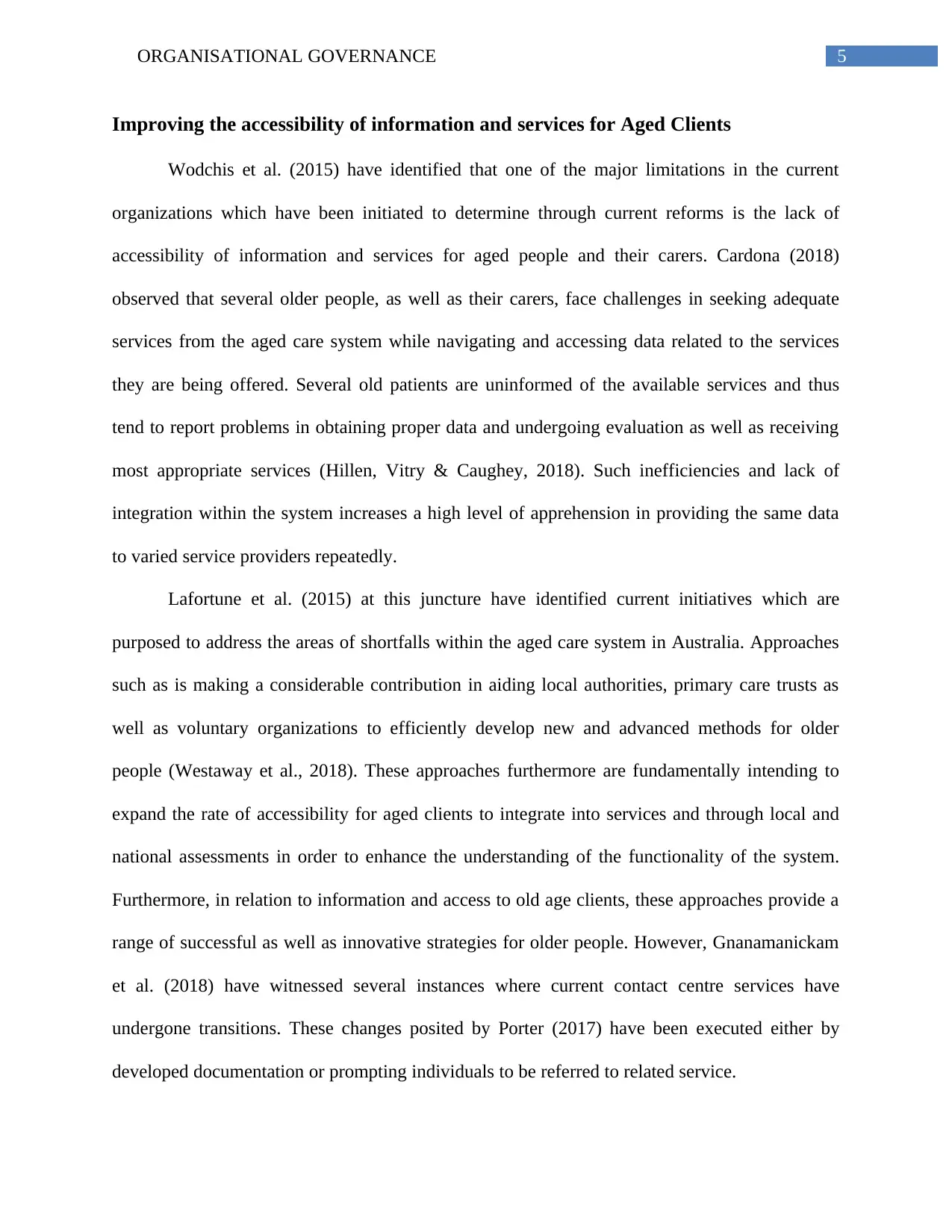
5ORGANISATIONAL GOVERNANCE
Improving the accessibility of information and services for Aged Clients
Wodchis et al. (2015) have identified that one of the major limitations in the current
organizations which have been initiated to determine through current reforms is the lack of
accessibility of information and services for aged people and their carers. Cardona (2018)
observed that several older people, as well as their carers, face challenges in seeking adequate
services from the aged care system while navigating and accessing data related to the services
they are being offered. Several old patients are uninformed of the available services and thus
tend to report problems in obtaining proper data and undergoing evaluation as well as receiving
most appropriate services (Hillen, Vitry & Caughey, 2018). Such inefficiencies and lack of
integration within the system increases a high level of apprehension in providing the same data
to varied service providers repeatedly.
Lafortune et al. (2015) at this juncture have identified current initiatives which are
purposed to address the areas of shortfalls within the aged care system in Australia. Approaches
such as is making a considerable contribution in aiding local authorities, primary care trusts as
well as voluntary organizations to efficiently develop new and advanced methods for older
people (Westaway et al., 2018). These approaches furthermore are fundamentally intending to
expand the rate of accessibility for aged clients to integrate into services and through local and
national assessments in order to enhance the understanding of the functionality of the system.
Furthermore, in relation to information and access to old age clients, these approaches provide a
range of successful as well as innovative strategies for older people. However, Gnanamanickam
et al. (2018) have witnessed several instances where current contact centre services have
undergone transitions. These changes posited by Porter (2017) have been executed either by
developed documentation or prompting individuals to be referred to related service.
Improving the accessibility of information and services for Aged Clients
Wodchis et al. (2015) have identified that one of the major limitations in the current
organizations which have been initiated to determine through current reforms is the lack of
accessibility of information and services for aged people and their carers. Cardona (2018)
observed that several older people, as well as their carers, face challenges in seeking adequate
services from the aged care system while navigating and accessing data related to the services
they are being offered. Several old patients are uninformed of the available services and thus
tend to report problems in obtaining proper data and undergoing evaluation as well as receiving
most appropriate services (Hillen, Vitry & Caughey, 2018). Such inefficiencies and lack of
integration within the system increases a high level of apprehension in providing the same data
to varied service providers repeatedly.
Lafortune et al. (2015) at this juncture have identified current initiatives which are
purposed to address the areas of shortfalls within the aged care system in Australia. Approaches
such as is making a considerable contribution in aiding local authorities, primary care trusts as
well as voluntary organizations to efficiently develop new and advanced methods for older
people (Westaway et al., 2018). These approaches furthermore are fundamentally intending to
expand the rate of accessibility for aged clients to integrate into services and through local and
national assessments in order to enhance the understanding of the functionality of the system.
Furthermore, in relation to information and access to old age clients, these approaches provide a
range of successful as well as innovative strategies for older people. However, Gnanamanickam
et al. (2018) have witnessed several instances where current contact centre services have
undergone transitions. These changes posited by Porter (2017) have been executed either by
developed documentation or prompting individuals to be referred to related service.
⊘ This is a preview!⊘
Do you want full access?
Subscribe today to unlock all pages.

Trusted by 1+ million students worldwide
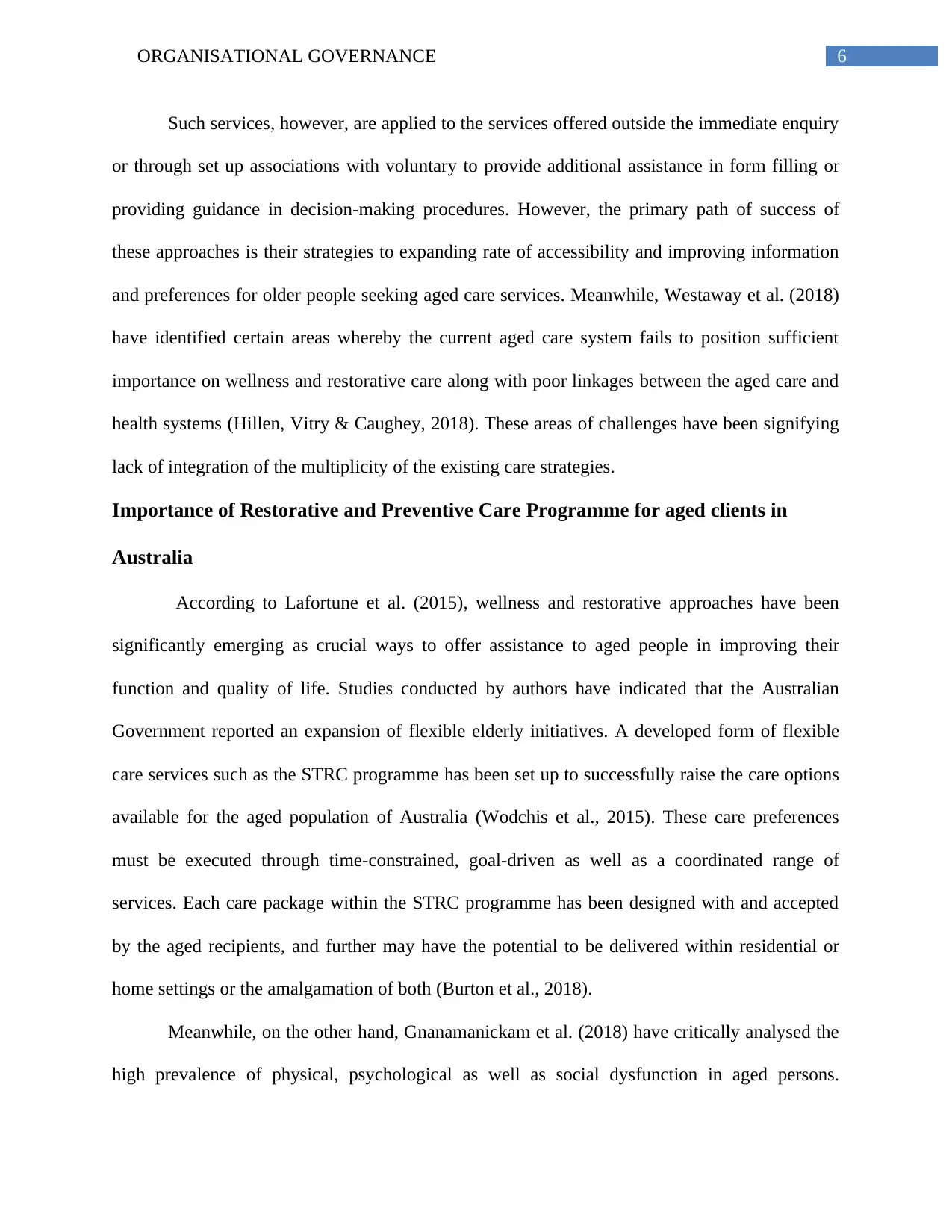
6ORGANISATIONAL GOVERNANCE
Such services, however, are applied to the services offered outside the immediate enquiry
or through set up associations with voluntary to provide additional assistance in form filling or
providing guidance in decision-making procedures. However, the primary path of success of
these approaches is their strategies to expanding rate of accessibility and improving information
and preferences for older people seeking aged care services. Meanwhile, Westaway et al. (2018)
have identified certain areas whereby the current aged care system fails to position sufficient
importance on wellness and restorative care along with poor linkages between the aged care and
health systems (Hillen, Vitry & Caughey, 2018). These areas of challenges have been signifying
lack of integration of the multiplicity of the existing care strategies.
Importance of Restorative and Preventive Care Programme for aged clients in
Australia
According to Lafortune et al. (2015), wellness and restorative approaches have been
significantly emerging as crucial ways to offer assistance to aged people in improving their
function and quality of life. Studies conducted by authors have indicated that the Australian
Government reported an expansion of flexible elderly initiatives. A developed form of flexible
care services such as the STRC programme has been set up to successfully raise the care options
available for the aged population of Australia (Wodchis et al., 2015). These care preferences
must be executed through time-constrained, goal-driven as well as a coordinated range of
services. Each care package within the STRC programme has been designed with and accepted
by the aged recipients, and further may have the potential to be delivered within residential or
home settings or the amalgamation of both (Burton et al., 2018).
Meanwhile, on the other hand, Gnanamanickam et al. (2018) have critically analysed the
high prevalence of physical, psychological as well as social dysfunction in aged persons.
Such services, however, are applied to the services offered outside the immediate enquiry
or through set up associations with voluntary to provide additional assistance in form filling or
providing guidance in decision-making procedures. However, the primary path of success of
these approaches is their strategies to expanding rate of accessibility and improving information
and preferences for older people seeking aged care services. Meanwhile, Westaway et al. (2018)
have identified certain areas whereby the current aged care system fails to position sufficient
importance on wellness and restorative care along with poor linkages between the aged care and
health systems (Hillen, Vitry & Caughey, 2018). These areas of challenges have been signifying
lack of integration of the multiplicity of the existing care strategies.
Importance of Restorative and Preventive Care Programme for aged clients in
Australia
According to Lafortune et al. (2015), wellness and restorative approaches have been
significantly emerging as crucial ways to offer assistance to aged people in improving their
function and quality of life. Studies conducted by authors have indicated that the Australian
Government reported an expansion of flexible elderly initiatives. A developed form of flexible
care services such as the STRC programme has been set up to successfully raise the care options
available for the aged population of Australia (Wodchis et al., 2015). These care preferences
must be executed through time-constrained, goal-driven as well as a coordinated range of
services. Each care package within the STRC programme has been designed with and accepted
by the aged recipients, and further may have the potential to be delivered within residential or
home settings or the amalgamation of both (Burton et al., 2018).
Meanwhile, on the other hand, Gnanamanickam et al. (2018) have critically analysed the
high prevalence of physical, psychological as well as social dysfunction in aged persons.
Paraphrase This Document
Need a fresh take? Get an instant paraphrase of this document with our AI Paraphraser
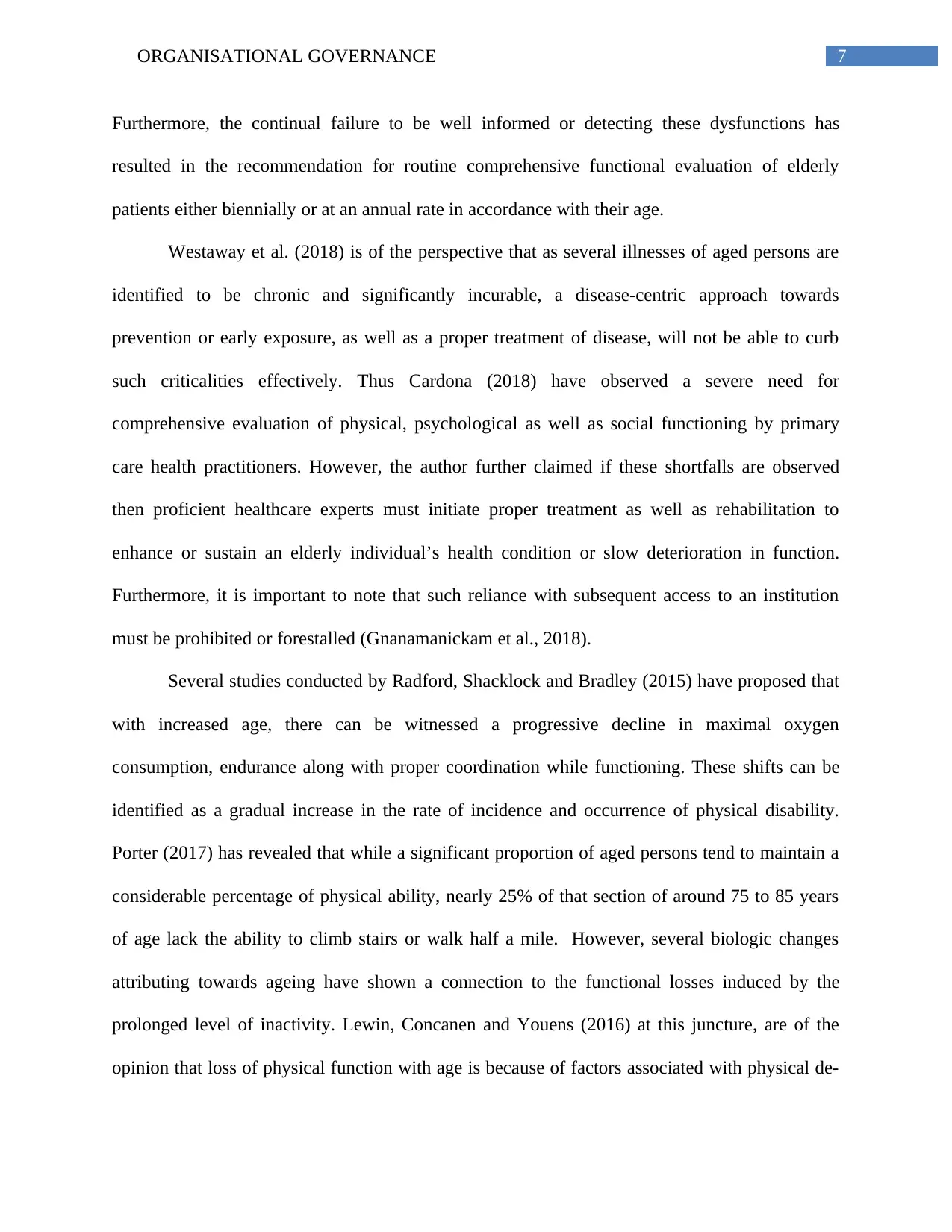
7ORGANISATIONAL GOVERNANCE
Furthermore, the continual failure to be well informed or detecting these dysfunctions has
resulted in the recommendation for routine comprehensive functional evaluation of elderly
patients either biennially or at an annual rate in accordance with their age.
Westaway et al. (2018) is of the perspective that as several illnesses of aged persons are
identified to be chronic and significantly incurable, a disease-centric approach towards
prevention or early exposure, as well as a proper treatment of disease, will not be able to curb
such criticalities effectively. Thus Cardona (2018) have observed a severe need for
comprehensive evaluation of physical, psychological as well as social functioning by primary
care health practitioners. However, the author further claimed if these shortfalls are observed
then proficient healthcare experts must initiate proper treatment as well as rehabilitation to
enhance or sustain an elderly individual’s health condition or slow deterioration in function.
Furthermore, it is important to note that such reliance with subsequent access to an institution
must be prohibited or forestalled (Gnanamanickam et al., 2018).
Several studies conducted by Radford, Shacklock and Bradley (2015) have proposed that
with increased age, there can be witnessed a progressive decline in maximal oxygen
consumption, endurance along with proper coordination while functioning. These shifts can be
identified as a gradual increase in the rate of incidence and occurrence of physical disability.
Porter (2017) has revealed that while a significant proportion of aged persons tend to maintain a
considerable percentage of physical ability, nearly 25% of that section of around 75 to 85 years
of age lack the ability to climb stairs or walk half a mile. However, several biologic changes
attributing towards ageing have shown a connection to the functional losses induced by the
prolonged level of inactivity. Lewin, Concanen and Youens (2016) at this juncture, are of the
opinion that loss of physical function with age is because of factors associated with physical de-
Furthermore, the continual failure to be well informed or detecting these dysfunctions has
resulted in the recommendation for routine comprehensive functional evaluation of elderly
patients either biennially or at an annual rate in accordance with their age.
Westaway et al. (2018) is of the perspective that as several illnesses of aged persons are
identified to be chronic and significantly incurable, a disease-centric approach towards
prevention or early exposure, as well as a proper treatment of disease, will not be able to curb
such criticalities effectively. Thus Cardona (2018) have observed a severe need for
comprehensive evaluation of physical, psychological as well as social functioning by primary
care health practitioners. However, the author further claimed if these shortfalls are observed
then proficient healthcare experts must initiate proper treatment as well as rehabilitation to
enhance or sustain an elderly individual’s health condition or slow deterioration in function.
Furthermore, it is important to note that such reliance with subsequent access to an institution
must be prohibited or forestalled (Gnanamanickam et al., 2018).
Several studies conducted by Radford, Shacklock and Bradley (2015) have proposed that
with increased age, there can be witnessed a progressive decline in maximal oxygen
consumption, endurance along with proper coordination while functioning. These shifts can be
identified as a gradual increase in the rate of incidence and occurrence of physical disability.
Porter (2017) has revealed that while a significant proportion of aged persons tend to maintain a
considerable percentage of physical ability, nearly 25% of that section of around 75 to 85 years
of age lack the ability to climb stairs or walk half a mile. However, several biologic changes
attributing towards ageing have shown a connection to the functional losses induced by the
prolonged level of inactivity. Lewin, Concanen and Youens (2016) at this juncture, are of the
opinion that loss of physical function with age is because of factors associated with physical de-
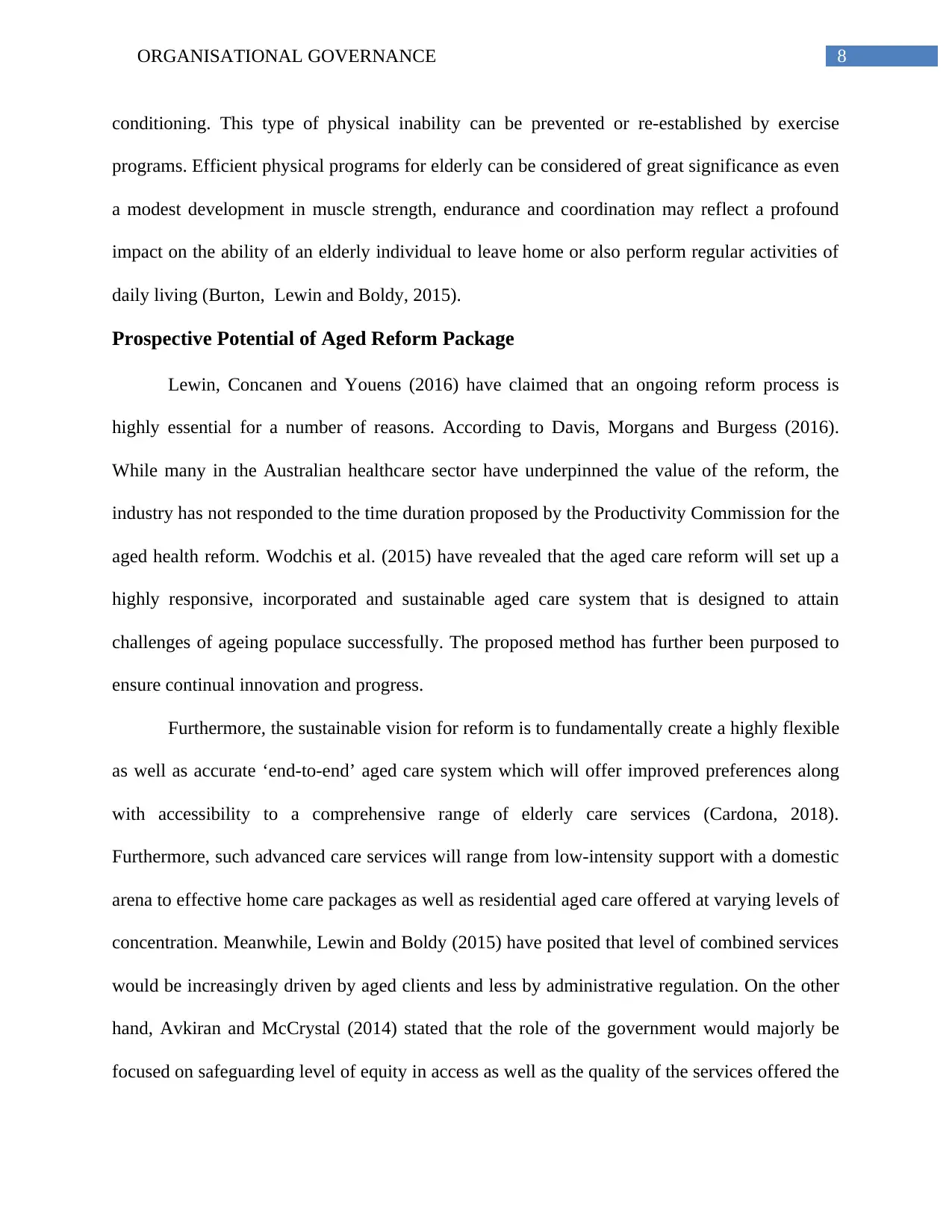
8ORGANISATIONAL GOVERNANCE
conditioning. This type of physical inability can be prevented or re-established by exercise
programs. Efficient physical programs for elderly can be considered of great significance as even
a modest development in muscle strength, endurance and coordination may reflect a profound
impact on the ability of an elderly individual to leave home or also perform regular activities of
daily living (Burton, Lewin and Boldy, 2015).
Prospective Potential of Aged Reform Package
Lewin, Concanen and Youens (2016) have claimed that an ongoing reform process is
highly essential for a number of reasons. According to Davis, Morgans and Burgess (2016).
While many in the Australian healthcare sector have underpinned the value of the reform, the
industry has not responded to the time duration proposed by the Productivity Commission for the
aged health reform. Wodchis et al. (2015) have revealed that the aged care reform will set up a
highly responsive, incorporated and sustainable aged care system that is designed to attain
challenges of ageing populace successfully. The proposed method has further been purposed to
ensure continual innovation and progress.
Furthermore, the sustainable vision for reform is to fundamentally create a highly flexible
as well as accurate ‘end-to-end’ aged care system which will offer improved preferences along
with accessibility to a comprehensive range of elderly care services (Cardona, 2018).
Furthermore, such advanced care services will range from low-intensity support with a domestic
arena to effective home care packages as well as residential aged care offered at varying levels of
concentration. Meanwhile, Lewin and Boldy (2015) have posited that level of combined services
would be increasingly driven by aged clients and less by administrative regulation. On the other
hand, Avkiran and McCrystal (2014) stated that the role of the government would majorly be
focused on safeguarding level of equity in access as well as the quality of the services offered the
conditioning. This type of physical inability can be prevented or re-established by exercise
programs. Efficient physical programs for elderly can be considered of great significance as even
a modest development in muscle strength, endurance and coordination may reflect a profound
impact on the ability of an elderly individual to leave home or also perform regular activities of
daily living (Burton, Lewin and Boldy, 2015).
Prospective Potential of Aged Reform Package
Lewin, Concanen and Youens (2016) have claimed that an ongoing reform process is
highly essential for a number of reasons. According to Davis, Morgans and Burgess (2016).
While many in the Australian healthcare sector have underpinned the value of the reform, the
industry has not responded to the time duration proposed by the Productivity Commission for the
aged health reform. Wodchis et al. (2015) have revealed that the aged care reform will set up a
highly responsive, incorporated and sustainable aged care system that is designed to attain
challenges of ageing populace successfully. The proposed method has further been purposed to
ensure continual innovation and progress.
Furthermore, the sustainable vision for reform is to fundamentally create a highly flexible
as well as accurate ‘end-to-end’ aged care system which will offer improved preferences along
with accessibility to a comprehensive range of elderly care services (Cardona, 2018).
Furthermore, such advanced care services will range from low-intensity support with a domestic
arena to effective home care packages as well as residential aged care offered at varying levels of
concentration. Meanwhile, Lewin and Boldy (2015) have posited that level of combined services
would be increasingly driven by aged clients and less by administrative regulation. On the other
hand, Avkiran and McCrystal (2014) stated that the role of the government would majorly be
focused on safeguarding level of equity in access as well as the quality of the services offered the
⊘ This is a preview!⊘
Do you want full access?
Subscribe today to unlock all pages.

Trusted by 1+ million students worldwide
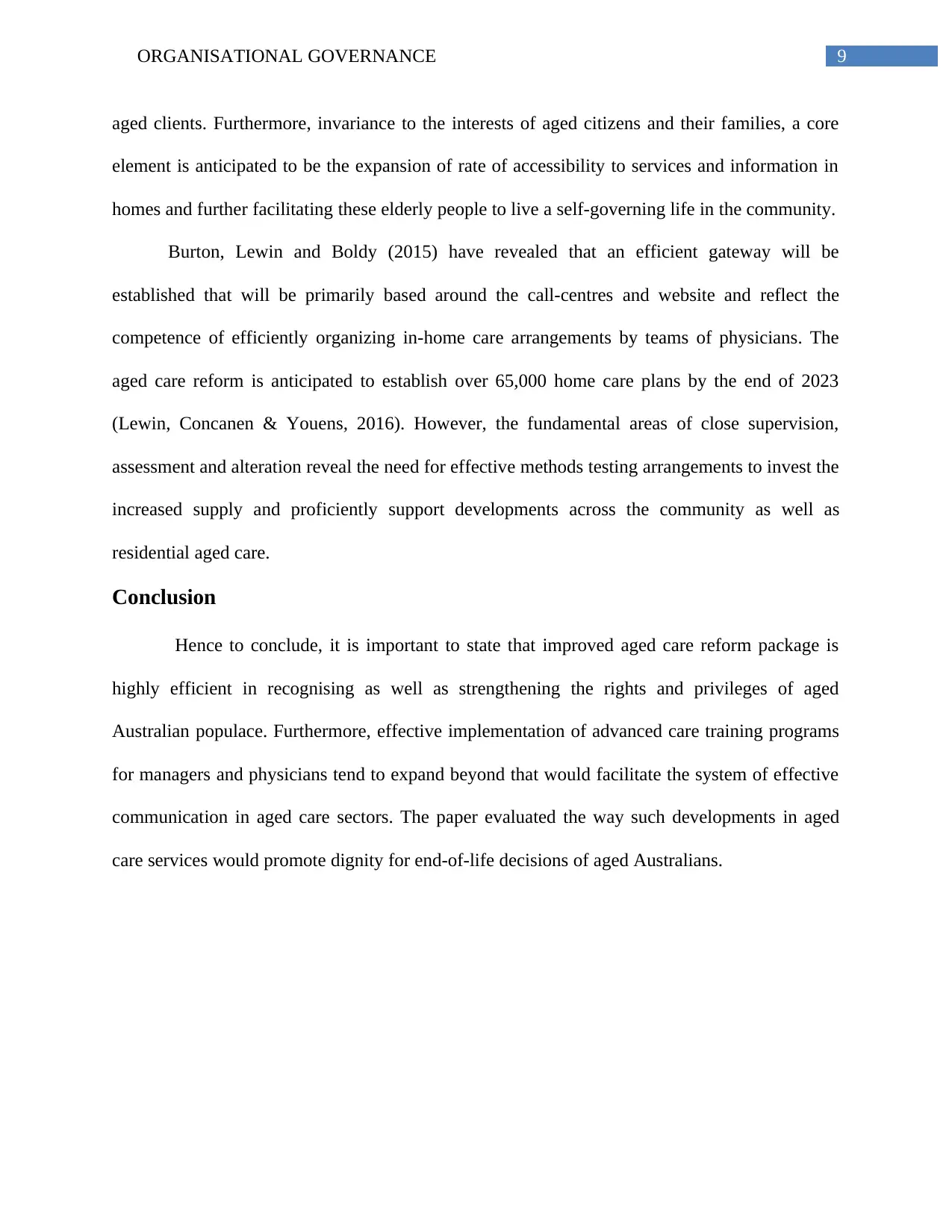
9ORGANISATIONAL GOVERNANCE
aged clients. Furthermore, invariance to the interests of aged citizens and their families, a core
element is anticipated to be the expansion of rate of accessibility to services and information in
homes and further facilitating these elderly people to live a self-governing life in the community.
Burton, Lewin and Boldy (2015) have revealed that an efficient gateway will be
established that will be primarily based around the call-centres and website and reflect the
competence of efficiently organizing in-home care arrangements by teams of physicians. The
aged care reform is anticipated to establish over 65,000 home care plans by the end of 2023
(Lewin, Concanen & Youens, 2016). However, the fundamental areas of close supervision,
assessment and alteration reveal the need for effective methods testing arrangements to invest the
increased supply and proficiently support developments across the community as well as
residential aged care.
Conclusion
Hence to conclude, it is important to state that improved aged care reform package is
highly efficient in recognising as well as strengthening the rights and privileges of aged
Australian populace. Furthermore, effective implementation of advanced care training programs
for managers and physicians tend to expand beyond that would facilitate the system of effective
communication in aged care sectors. The paper evaluated the way such developments in aged
care services would promote dignity for end-of-life decisions of aged Australians.
aged clients. Furthermore, invariance to the interests of aged citizens and their families, a core
element is anticipated to be the expansion of rate of accessibility to services and information in
homes and further facilitating these elderly people to live a self-governing life in the community.
Burton, Lewin and Boldy (2015) have revealed that an efficient gateway will be
established that will be primarily based around the call-centres and website and reflect the
competence of efficiently organizing in-home care arrangements by teams of physicians. The
aged care reform is anticipated to establish over 65,000 home care plans by the end of 2023
(Lewin, Concanen & Youens, 2016). However, the fundamental areas of close supervision,
assessment and alteration reveal the need for effective methods testing arrangements to invest the
increased supply and proficiently support developments across the community as well as
residential aged care.
Conclusion
Hence to conclude, it is important to state that improved aged care reform package is
highly efficient in recognising as well as strengthening the rights and privileges of aged
Australian populace. Furthermore, effective implementation of advanced care training programs
for managers and physicians tend to expand beyond that would facilitate the system of effective
communication in aged care sectors. The paper evaluated the way such developments in aged
care services would promote dignity for end-of-life decisions of aged Australians.
Paraphrase This Document
Need a fresh take? Get an instant paraphrase of this document with our AI Paraphraser
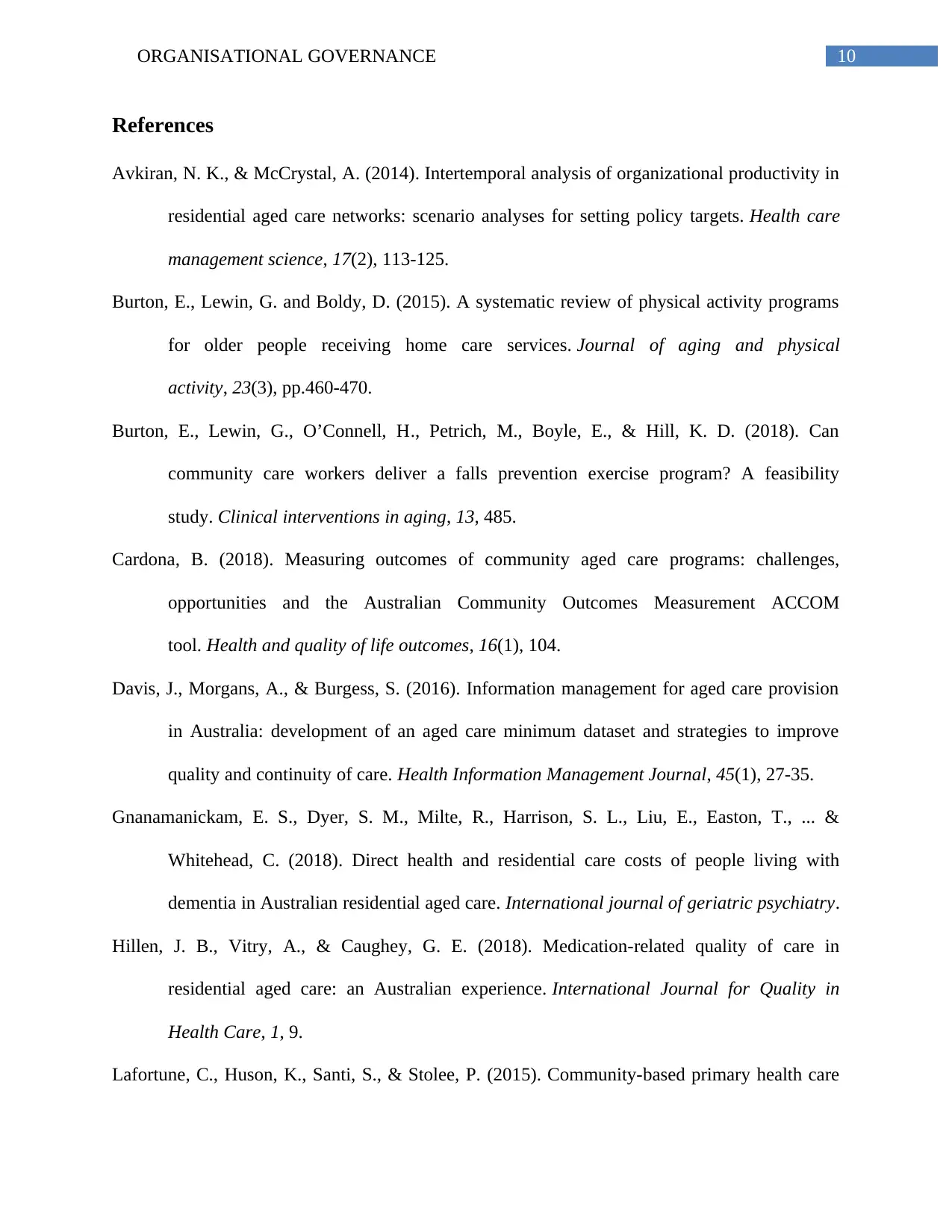
10ORGANISATIONAL GOVERNANCE
References
Avkiran, N. K., & McCrystal, A. (2014). Intertemporal analysis of organizational productivity in
residential aged care networks: scenario analyses for setting policy targets. Health care
management science, 17(2), 113-125.
Burton, E., Lewin, G. and Boldy, D. (2015). A systematic review of physical activity programs
for older people receiving home care services. Journal of aging and physical
activity, 23(3), pp.460-470.
Burton, E., Lewin, G., O’Connell, H., Petrich, M., Boyle, E., & Hill, K. D. (2018). Can
community care workers deliver a falls prevention exercise program? A feasibility
study. Clinical interventions in aging, 13, 485.
Cardona, B. (2018). Measuring outcomes of community aged care programs: challenges,
opportunities and the Australian Community Outcomes Measurement ACCOM
tool. Health and quality of life outcomes, 16(1), 104.
Davis, J., Morgans, A., & Burgess, S. (2016). Information management for aged care provision
in Australia: development of an aged care minimum dataset and strategies to improve
quality and continuity of care. Health Information Management Journal, 45(1), 27-35.
Gnanamanickam, E. S., Dyer, S. M., Milte, R., Harrison, S. L., Liu, E., Easton, T., ... &
Whitehead, C. (2018). Direct health and residential care costs of people living with
dementia in Australian residential aged care. International journal of geriatric psychiatry.
Hillen, J. B., Vitry, A., & Caughey, G. E. (2018). Medication-related quality of care in
residential aged care: an Australian experience. International Journal for Quality in
Health Care, 1, 9.
Lafortune, C., Huson, K., Santi, S., & Stolee, P. (2015). Community-based primary health care
References
Avkiran, N. K., & McCrystal, A. (2014). Intertemporal analysis of organizational productivity in
residential aged care networks: scenario analyses for setting policy targets. Health care
management science, 17(2), 113-125.
Burton, E., Lewin, G. and Boldy, D. (2015). A systematic review of physical activity programs
for older people receiving home care services. Journal of aging and physical
activity, 23(3), pp.460-470.
Burton, E., Lewin, G., O’Connell, H., Petrich, M., Boyle, E., & Hill, K. D. (2018). Can
community care workers deliver a falls prevention exercise program? A feasibility
study. Clinical interventions in aging, 13, 485.
Cardona, B. (2018). Measuring outcomes of community aged care programs: challenges,
opportunities and the Australian Community Outcomes Measurement ACCOM
tool. Health and quality of life outcomes, 16(1), 104.
Davis, J., Morgans, A., & Burgess, S. (2016). Information management for aged care provision
in Australia: development of an aged care minimum dataset and strategies to improve
quality and continuity of care. Health Information Management Journal, 45(1), 27-35.
Gnanamanickam, E. S., Dyer, S. M., Milte, R., Harrison, S. L., Liu, E., Easton, T., ... &
Whitehead, C. (2018). Direct health and residential care costs of people living with
dementia in Australian residential aged care. International journal of geriatric psychiatry.
Hillen, J. B., Vitry, A., & Caughey, G. E. (2018). Medication-related quality of care in
residential aged care: an Australian experience. International Journal for Quality in
Health Care, 1, 9.
Lafortune, C., Huson, K., Santi, S., & Stolee, P. (2015). Community-based primary health care
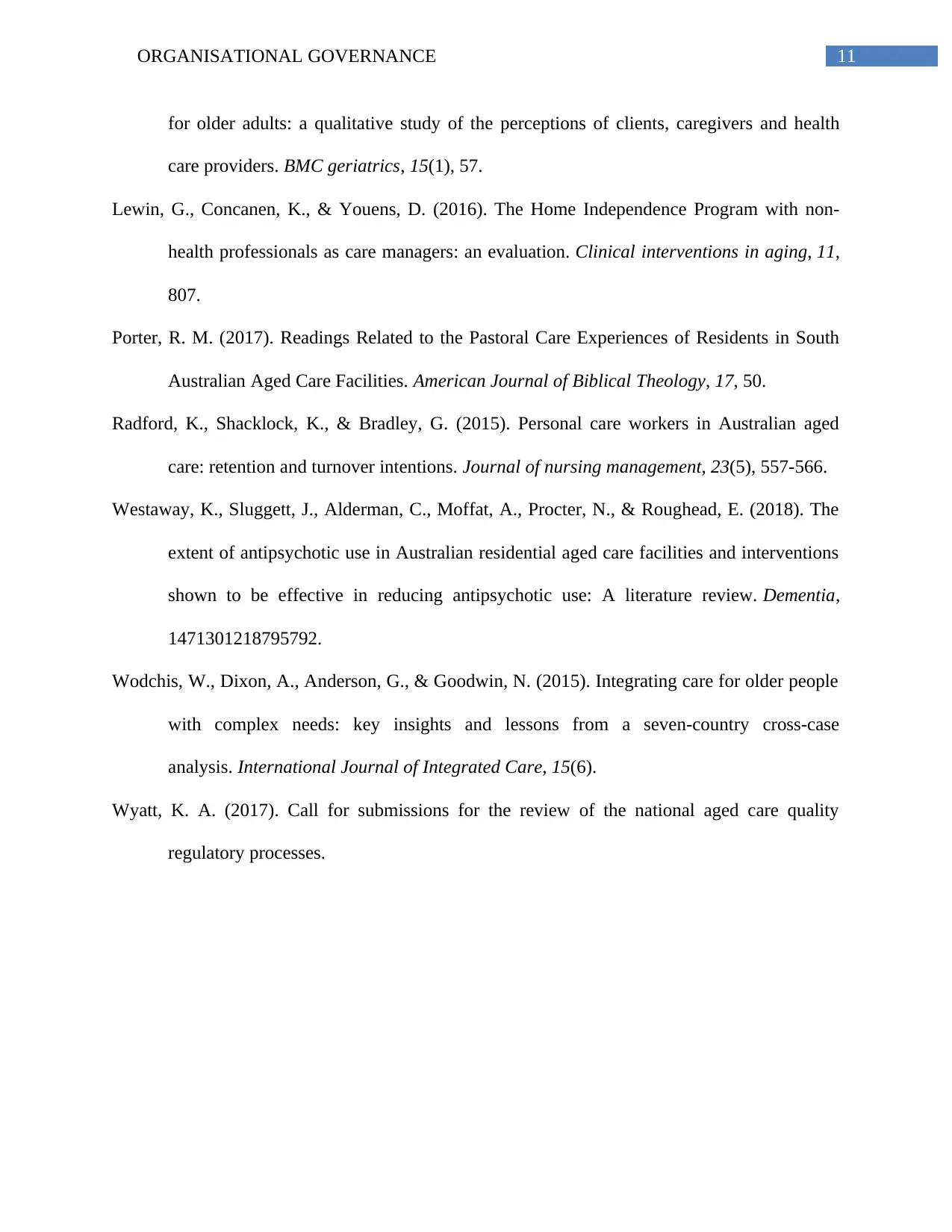
11ORGANISATIONAL GOVERNANCE
for older adults: a qualitative study of the perceptions of clients, caregivers and health
care providers. BMC geriatrics, 15(1), 57.
Lewin, G., Concanen, K., & Youens, D. (2016). The Home Independence Program with non-
health professionals as care managers: an evaluation. Clinical interventions in aging, 11,
807.
Porter, R. M. (2017). Readings Related to the Pastoral Care Experiences of Residents in South
Australian Aged Care Facilities. American Journal of Biblical Theology, 17, 50.
Radford, K., Shacklock, K., & Bradley, G. (2015). Personal care workers in Australian aged
care: retention and turnover intentions. Journal of nursing management, 23(5), 557-566.
Westaway, K., Sluggett, J., Alderman, C., Moffat, A., Procter, N., & Roughead, E. (2018). The
extent of antipsychotic use in Australian residential aged care facilities and interventions
shown to be effective in reducing antipsychotic use: A literature review. Dementia,
1471301218795792.
Wodchis, W., Dixon, A., Anderson, G., & Goodwin, N. (2015). Integrating care for older people
with complex needs: key insights and lessons from a seven-country cross-case
analysis. International Journal of Integrated Care, 15(6).
Wyatt, K. A. (2017). Call for submissions for the review of the national aged care quality
regulatory processes.
for older adults: a qualitative study of the perceptions of clients, caregivers and health
care providers. BMC geriatrics, 15(1), 57.
Lewin, G., Concanen, K., & Youens, D. (2016). The Home Independence Program with non-
health professionals as care managers: an evaluation. Clinical interventions in aging, 11,
807.
Porter, R. M. (2017). Readings Related to the Pastoral Care Experiences of Residents in South
Australian Aged Care Facilities. American Journal of Biblical Theology, 17, 50.
Radford, K., Shacklock, K., & Bradley, G. (2015). Personal care workers in Australian aged
care: retention and turnover intentions. Journal of nursing management, 23(5), 557-566.
Westaway, K., Sluggett, J., Alderman, C., Moffat, A., Procter, N., & Roughead, E. (2018). The
extent of antipsychotic use in Australian residential aged care facilities and interventions
shown to be effective in reducing antipsychotic use: A literature review. Dementia,
1471301218795792.
Wodchis, W., Dixon, A., Anderson, G., & Goodwin, N. (2015). Integrating care for older people
with complex needs: key insights and lessons from a seven-country cross-case
analysis. International Journal of Integrated Care, 15(6).
Wyatt, K. A. (2017). Call for submissions for the review of the national aged care quality
regulatory processes.
⊘ This is a preview!⊘
Do you want full access?
Subscribe today to unlock all pages.

Trusted by 1+ million students worldwide
1 out of 12
Related Documents
Your All-in-One AI-Powered Toolkit for Academic Success.
+13062052269
info@desklib.com
Available 24*7 on WhatsApp / Email
![[object Object]](/_next/static/media/star-bottom.7253800d.svg)
Unlock your academic potential
Copyright © 2020–2025 A2Z Services. All Rights Reserved. Developed and managed by ZUCOL.




